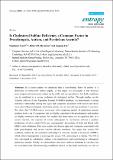| dc.contributor.author | Seneff, Stephanie | |
| dc.contributor.author | Davidson, Robert M. | |
| dc.contributor.author | Liu, Jingjing | |
| dc.date.accessioned | 2013-03-06T15:26:10Z | |
| dc.date.available | 2013-03-06T15:26:10Z | |
| dc.date.issued | 2012-11 | |
| dc.date.submitted | 2012-10 | |
| dc.identifier.issn | 1099-4300 | |
| dc.identifier.uri | http://hdl.handle.net/1721.1/77573 | |
| dc.description.abstract | In a recent paper, we proposed that a contributing factor in autism is a deficiency in cholesterol sulfate supply. In this paper, we investigate a link between preeclampsia and subsequent autism in the child, and we hypothesize that both conditions can be attributed to a severe depletion of cholesterol sulfate. Through studies on the Vaccine Adverse Event Reporting System (VAERS) database, we demonstrate a strong statistical relationship among the signs and symptoms associated with autism and those associated with preeclampsia, pernicious anemia, and serious adverse reactions to vaccines. We show that VAERS reports associated with symptoms typical of pernicious anemia produce both a set of symptoms that are highly correlated with preeclampsia and another set highly correlated with autism. We explain this observation via an argument that, in a severe reaction, the cascade of events subsequent to vaccination reflects a profuse production of nitric oxide (NO) and consequential destruction of both red blood cells (RBCs) and cobalamin. This may explain the diverse signs and symptoms associated with both preeclampsia and severe vaccine adverse reactions. We argue that excess NO synthesis, induced by the aluminum and antigen in vaccines, results in hemolysis of RBCs, which allows hemoglobin to scavenge the excess NO, converting it to nitrate. The NO is also scavenged by cobalamin, leading to its inactivation and contributing to subsequent pernicious anemia. Finally, we demonstrate that severe adverse reactions to vaccines can be associated with life-threatening conditions related to the heart and brain, as well as stillbirth, when the vaccine is administered to a woman in the third-trimester of pregnancy, as demonstrated by statistical analysis of the Gardasil records. | en_US |
| dc.language.iso | en_US | |
| dc.publisher | MDPI AG | en_US |
| dc.relation.isversionof | http://dx.doi.org/10.3390/e14112265 | en_US |
| dc.rights | Creative Commons Attribution 3.0 | en_US |
| dc.rights.uri | http://creativecommons.org/licenses/by/3.0/ | en_US |
| dc.source | MDPI Publishing | en_US |
| dc.title | Is Cholesterol Sulfate Deficiency a Common Factor in Preeclampsia, Autism, and Pernicious Anemia? | en_US |
| dc.type | Article | en_US |
| dc.identifier.citation | Seneff, Stephanie, Robert Davidson, and Jingjing Liu. “Is Cholesterol Sulfate Deficiency a Common Factor in Preeclampsia, Autism, and Pernicious Anemia?” Entropy 14.12 (2012): 2265–2290. ©2012 MDPI AG | en_US |
| dc.contributor.department | Massachusetts Institute of Technology. Computer Science and Artificial Intelligence Laboratory | en_US |
| dc.contributor.mitauthor | Seneff, Stephanie | |
| dc.contributor.mitauthor | Liu, Jingjing | |
| dc.relation.journal | Entropy | en_US |
| dc.eprint.version | Final published version | en_US |
| dc.type.uri | http://purl.org/eprint/type/JournalArticle | en_US |
| eprint.status | http://purl.org/eprint/status/PeerReviewed | en_US |
| dspace.orderedauthors | Seneff, Stephanie; Davidson, Robert; Liu, Jingjing | en |
| dc.identifier.orcid | https://orcid.org/0000-0001-8191-1049 | |
| mit.license | PUBLISHER_CC | en_US |
| mit.metadata.status | Complete | |
